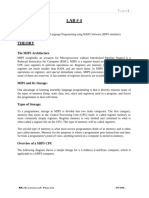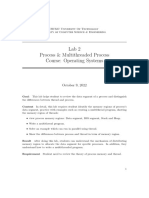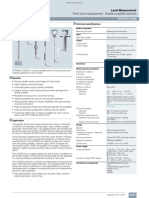SysMem V3x E
SysMem V3x E
Uploaded by
muhamad.badar9285Copyright:
Available Formats
SysMem V3x E
SysMem V3x E
Uploaded by
muhamad.badar9285Original Description:
Copyright
Available Formats
Share this document
Did you find this document useful?
Is this content inappropriate?
Copyright:
Available Formats
SysMem V3x E
SysMem V3x E
Uploaded by
muhamad.badar9285Copyright:
Available Formats
Library Description:
CoDeSys V 3.x
SysMem.library
Document Version 1.0
libdoc_e.dot / V1.0
3S - Smart Software Solutions GmbH page 1 of 10
SysMem_V3x_E.doc
Library SysMem.library
CONTENT
1 OVERVIEW 4
2 LIBRARY MODULES 5
2.1 SysMemAllocArea 5
2.2 SysMemAllocCode 5
2.3 SysMemAllocData 5
2.4 SysMemCmp 6
2.5 SysMemCpy 6
2.6 SysMemForceSwap 6
2.7 SysMemFreeArea 7
2.8 SysMemFreeCode 7
2.9 SysMemFreeData 7
2.10 SysMemIsValidPointer 8
2.11 SysMemMove 8
2.12 SysMemReallocData 8
2.13 SysMemSet 9
2.14 SysMemSwap 9
CHANGE HISTORY 10
libdoc_e.dot / V1.0
3S - Smart Software Solutions GmbH page 3 of 10
SysMem_V3x_E.doc
Library SysMem.library
1 Overview
Note: It depends on the target system, which system libraries can be used in the application program.
This library conduces to memory management. Provided that the library functions are
supported by the target system they can be used to allocate or release memory, to define or
compare memory spaces, to copy the content of one memory to another or to swap. The
processing is synchronous.
The following functions are available:
SysMemAllocArea
SysMemAllocCode
SysMemAllocData
SysMemCmp
SysMemCpy
SysMemForceSwap
SysMemFreeArea
SysMemFreeCode
SysMemFreeData
SysMemIsValidPointer
SysMemMove
SysMemReallocData
SysMemSet
SysMemSwap
libdoc_e.dot / V1.0
3S - Smart Software Solutions GmbH page 4 of 10
SysMem_V3x_E.doc
Library SysMem.library
2 Library Modules
2.1 SysMemAllocArea
This function dynamically allocates a memory area for an application. Therefor, the
component requesting memory has to be indicated as well as the required category and size
of memory.
The return of type POINTER TO BYTE is a pointer to the memory space reserved. In case of
the requested memory not being available, the NULL pointer will be returned. Therefore one
should always check the return even in case of small memory amount requested!
Input variable Data type Description
szComponent POINTER TO Pointer to string being assigned to name of
STRING component that is requiring memory
usType WORD Category of memory space, e.g. PERSISTENT
udiSize UDINT Number of bytes to be allocated
pResult PONTER TO UDINT Pointer to error code; see document "Runtime Error
Codes"; (may be NULL)
2.2 SysMemAllocCode
This function allocates memory space for code, wherein the code is executable. Therefore,
function SysMemAllocCode is mainly helpful for computer architectures that prevent the
default memory from executing of code. In addition to the memory size required one has to
indicate the component that is requesting memory.
The return of type POINTER TO BYTE is a pointer to the memory space reserved. In case of
the requested memory not being available, the NULL pointer will be returned. Therefore one
should always check the return even in case of small memory amount requested!
Input variable Data type Description
szComponent POINTER TO Pointer to string being assigned to name of
STRING component that is requiring memory
udiSize UDINT Number of bytes to be allocated
pResult PONTER TO UDINT Pointer to error code; see document "Runtime Error
Codes"; (may be NULL)
2.3 SysMemAllocData
This function dynamically allocates data memory for an application. Therefor, the component
requesting memory has to be indicated as well as the required category and size of memory.
The return of type POINTER TO BYTE is a pointer to the memory space reserved. In case of
the requested memory not being available, the NULL pointer will be returned. Therefore one
should always check the return even in case of small memory amount requested!
libdoc_e.dot / V1.0
Input variable Data type Description
szComponent POINTER TO Pointer to string being assigned to name of
STRING component that is requiring memory
udiSize UDINT Number of bytes to be allocated
3S - Smart Software Solutions GmbH page 5 of 10
SysMem_V3x_E.doc
Library SysMem.library
pResult PONTER TO UDINT Pointer to error code; see document "Runtime Error
Codes"; (may be NULL)
2.4 SysMemCmp
By use of this function the content of two memory areas (buffer 1 and buffer 2) can be
compared.
The return of type DINT equals 0, if the content is identical. Otherwise, the function will return
a value unlike 0.
Input variable Data type Description
pBuffer1 POINTER TO BYTE Address of first memory area (buffer 1)
pBuffer2 POINTER TO BYTE Address of second memory area (buffer 2)
udiCount UDINT Number of bytes to be compared
2.5 SysMemCpy
By use of this function a specified number of location is copied from one memory space to
another. In difference to SysMemMove (2.11) copying is only possible on non-cohesive
memory areas.
The return of type POINTER TO BYTE is a pointer to the address of the target memory.
Input variable Data type Description
pDest POINTER TO BYTE Pointer to memory address to be copied to (target)
pSrc POINTER TO BYTE Pointer to memory address to be copied from (source)
udiCount UDINT Number of bytes to be copied
2.6 SysMemForceSwap
This function serves to swap data within memory areas. It is mainly used to convert data from
Intel byte order to Motorola byte order or vice versa.
In difference to SysMemSwap (2.14) the function SysMemForceSwap does not care for the
target system used!
The return of type DINT equals
-1, if udiSize was assigned to an invalid value.
a value >0, reflecting the number of bytes swapped. In particular: return 1, if buffer is
of type Motorola and function has been called with pbyBuffer =NULL
Input variable Data type Description
pbyBuffer POINTER TO BYTE Pointer to address of memory area to be swapped;
the function being called with NULL allows to check
which order is selected
libdoc_e.dot / V1.0
udiSize UDINT Number of positions forming a unit to be swapped;
valid: 2,4,8
udiCount UDINT Number of positions forming a unit to be swapped;
valid: 2,4,8
3S - Smart Software Solutions GmbH page 6 of 10
SysMem_V3x_E.doc
Library SysMem.library
2.7 SysMemFreeArea
This function serves to release (deallocate) a memory area having been allocated by
SysMemAllocArea. Calling this function one has to indicate the name of the component
having requested this memory area originally as well as the pointer to the associated memory
address.
The return is an error code indicating success or failure of the operation (see document
"Runtime Error Codes").
Input variable Data type Description
szComponent POINTER TO Pointer to string variable being assigned to the name
STRING of the component that originally had requested the
memory
pMemory POINTER TO BYTE Pointer to address of memory space to be released
2.8 SysMemFreeCode
This function serves to release (deallocate) a code memory area having been allocated by
SysMemAllocCode.
The return is an error code indicating success or failure of the operation (see document
"Runtime Error Codes").
Input variable Data type Description
szComponent POINTER TO Pointer to string variable being assigned to the name
STRING of the component that originally had requested the
memory
pMemory POINTER TO BYTE Pointer to address of memory space to be released
2.9 SysMemFreeData
This function serves to release (deallocate) a data memory area having been allocated by
SysMemAllocData.
The return is an error code indicating success or failure of the operation (see document
"Runtime Error Codes").
Input variable Data type Description
szComponent POINTER TO Pointer to string variable being assigned to the name
STRING of the component that originally had requested the
memory
pMemory POINTER TO BYTE Pointer to address of memory space to be released
libdoc_e.dot / V1.0
3S - Smart Software Solutions GmbH page 7 of 10
SysMem_V3x_E.doc
Library SysMem.library
2.10 SysMemIsValidPointer
This function checks if a pointer is assigned to a valid memory address.
The return is an error code indicating success or failure of the operation (see document
"Runtime Error Codes").
Input variable Data type Description
ptr POINTER TO BYTE Pointer to memory address to be checked
udiSize UDINT Size (number of bytes) of memory to be checked
bWrite BOOL FALSE: memory space is tested for read access.
TRUE: memory space is tested for write access.
2.11 SysMemMove
This function serves to copy the content of one memory area (source) to another (target).
Calling this function one has to transmit to pointers pointing to the address of source and
target memory.
In difference to SysMemCpy (2.5) the memory spaces of source and target may belong to a
cohesive memory area and even overlap.
The return of type UDINT is the address of the target memory.
Input variable Data type Description
pDest POINTER TO BYTE Pointer to memory address to be copied to (target)
pSrc POINTER TO BYTE Pointer to memory address to be copied from (source)
udiCount UDINT Number of bytes to be copied
2.12 SysMemReallocData
By use of this function the size of a memory block can be modified (reallocation). Therefor a
pointer on the memory block to be reallocated is passed to the function. The content of the
memory block will not be modified.
If the requested memory size cannot made available at the same place (address) , the
function will allocate new memory space, copy the original content to the new memory and
release the old one.
The return is an error code indicating success or failure of the operation (see document
"Runtime Error Codes").
Input variable Data type Description
szComponent POINTER TO Pointer to string variable being assigned to the name
STRING of the component that originally had requested the
memory
pMemory POINTER TO BYTE Pointer to memory address to be reallocated
libdoc_e.dot / V1.0
udiSize UDINT Required Size of memory (in bytes).
pResult PONTER TO UDINT Pointer to error code; (may be NULL, if no memory is
available)
3S - Smart Software Solutions GmbH page 8 of 10
SysMem_V3x_E.doc
Library SysMem.library
2.13 SysMemSet
By use of this function a memory space is initialized with a specified value.
The return is an error code indicating success or failure of the operation (see document
"Runtime Error Codes").
Input variable Data type Description
pDest POINTER TO BYTE Pointer to memory address to be initialized
udiValue UDINT Character or value the memory is to be assigned to
udiCount UDINT Number of bytes to be initialized
2.14 SysMemSwap
This function serves to swap data within memory areas. It is mainly used to convert data from
Intel byte order to Motorola byte order. Thereby portable libraries can be built.
Note: Swapping will only be executed on Motorola target systems (PPC), but not on Intel
target systems (ARM, MIPS, SH, x86). Otherwise see SysMemForceSwap (2.6).
The return of type DINT equals
-1, if udiSize was assigned to an invalid value.
0, if swapping is not necessary (i.e. the data already has Intel byte order).
a value >0 reflecting the number of bytes swapped. In particular: return 1, if buffer is
of type Motorola and function has been called with pbyBuffer =NULL
Input variable Data type Description
pbyBuffer POINTER TO BYTE Pointer to address of memory area to be swapped
udiSize UDINT Number of positions forming a unit to be swapped;
valid: 2,4,8
udiCount UDINT Number of bytes to be swapped
libdoc_e.dot / V1.0
3S - Smart Software Solutions GmbH page 9 of 10
SysMem_V3x_E.doc
Library SysMem.library
Change History
Version Description Date
0.1 Creation according to German version 1.0 20.02.2008
1.0 Release after formal review 20.02.2008
libdoc_e.dot / V1.0
3S - Smart Software Solutions GmbH page 10 of 10
SysMem_V3x_E.doc
You might also like
- SysCom V3x EDocument11 pagesSysCom V3x Emuhamad.badar9285No ratings yet
- Impact of Home Burglar Alarm SystemsDocument359 pagesImpact of Home Burglar Alarm Systemsmack100% (1)
- SysProcess V3x EDocument8 pagesSysProcess V3x Emuhamad.badar9285No ratings yet
- 01-stdlibDocument51 pages01-stdlib張智鈞No ratings yet
- Assembly - Memory SegmentsDocument2 pagesAssembly - Memory Segmentsmichal hanaNo ratings yet
- System Architecture: Lab Notes For Week 1: The MIPS CPU, Assembly Programming 1 Introduction To System ArchitectureDocument7 pagesSystem Architecture: Lab Notes For Week 1: The MIPS CPU, Assembly Programming 1 Introduction To System ArchitectureNabil AlzeqriNo ratings yet
- Inferno (1) .PsDocument4 pagesInferno (1) .PsAbdul DakkakNo ratings yet
- Lab 08Document10 pagesLab 08Quang LeNo ratings yet
- Mastering Stack and Heap For System ReliabilityDocument10 pagesMastering Stack and Heap For System Reliabilitystu807No ratings yet
- Tutorial - Supply ChainDocument30 pagesTutorial - Supply Chainasadcs50No ratings yet
- Performance of Systemverilog CodingDocument8 pagesPerformance of Systemverilog CodingmaxNo ratings yet
- SysTime V3x EDocument10 pagesSysTime V3x Emuhamad.badar9285No ratings yet
- Multiprocessor Simulators LVDocument18 pagesMultiprocessor Simulators LVBlackMajin24No ratings yet
- SC9 Architecure and Roles Quick Reference Guide v1Document14 pagesSC9 Architecure and Roles Quick Reference Guide v1Kiran PatilNo ratings yet
- Project 3Document13 pagesProject 3justin.muchunuNo ratings yet
- 19 Final Code GenerationDocument16 pages19 Final Code GenerationSmitha VasNo ratings yet
- Maximising MicroPython SpeedDocument9 pagesMaximising MicroPython SpeedsarbiniNo ratings yet
- BIT: A Very Compact Scheme System For MicrocontrollersDocument36 pagesBIT: A Very Compact Scheme System For Microcontrollersjblair33No ratings yet
- Writing Small Shellcode: Next Genera Tion Sec Urity Software LTDDocument15 pagesWriting Small Shellcode: Next Genera Tion Sec Urity Software LTDs34c0d3rNo ratings yet
- Lab#4 CompletedDocument15 pagesLab#4 CompletedHaris SardarNo ratings yet
- ProcessAddressSpace 2Document37 pagesProcessAddressSpace 2st.andrews.eveNo ratings yet
- Practical Guide To Wasm MemoryDocument15 pagesPractical Guide To Wasm Memoryp5nycgcwwrNo ratings yet
- Framework Internals - How The CLR Creates Runtime Objects - Microsoft DocsDocument19 pagesFramework Internals - How The CLR Creates Runtime Objects - Microsoft DocsVishalNo ratings yet
- Object:: The MIPS ArchitectureDocument14 pagesObject:: The MIPS ArchitectureEsha FayyazNo ratings yet
- db2 Cert9183 PDFDocument37 pagesdb2 Cert9183 PDFSergio LitumaNo ratings yet
- C20Document60 pagesC20arunascarletNo ratings yet
- Lab 08Document13 pagesLab 08aducbkfetNo ratings yet
- SysComAsync V3x EDocument6 pagesSysComAsync V3x Emuhamad.badar9285No ratings yet
- Self Modifying Code by Giovanni Tropeano: Vol. 1, No. 2, 2006Document6 pagesSelf Modifying Code by Giovanni Tropeano: Vol. 1, No. 2, 2006Aj WelchNo ratings yet
- Lab Manual of MPDocument35 pagesLab Manual of MPShaam mkNo ratings yet
- The Essential BYOM Manual: Tjalling Jager April 3, 2015Document18 pagesThe Essential BYOM Manual: Tjalling Jager April 3, 2015Davor Profesor100% (1)
- Sysvwaix Lpar PDFDocument50 pagesSysvwaix Lpar PDFdbf4mailNo ratings yet
- Lab 2 Process & Multithreaded Process Course: Operating SystemsDocument18 pagesLab 2 Process & Multithreaded Process Course: Operating SystemsNhân ChuNo ratings yet
- Reversing WasmDocument22 pagesReversing Wasmthe4powerNo ratings yet
- Emerging Database TechnologiesDocument5 pagesEmerging Database TechnologiesSatheswaran RajasegaranNo ratings yet
- Interview QuestionsDocument9 pagesInterview QuestionsSujeet KumarNo ratings yet
- Dynamic Management ViewsDocument11 pagesDynamic Management ViewsamoldhaygudeNo ratings yet
- AmigaAsmTutorial 1Document174 pagesAmigaAsmTutorial 1Milan ZaninovićNo ratings yet
- MIC QB DiplomaDocument7 pagesMIC QB DiplomaAditya KaraleNo ratings yet
- Os Placement NotesDocument26 pagesOs Placement Notesnothingnill28No ratings yet
- Programming Assignment IV Thursday, June 1, 2023 at 11:59pmDocument4 pagesProgramming Assignment IV Thursday, June 1, 2023 at 11:59pmAli RahimiNo ratings yet
- Lab Session 1Document13 pagesLab Session 1Kulsoom Nasir HussainNo ratings yet
- Soa Faq NewDocument36 pagesSoa Faq NewIrshadulla KayamkhaniNo ratings yet
- Part 1B, DR S.W. MooreDocument16 pagesPart 1B, DR S.W. MooreElliottRosenthal100% (3)
- Lab 2Document24 pagesLab 2Le Phu ThuanNo ratings yet
- Inter: iRMX® System Debugger Reference ManualDocument148 pagesInter: iRMX® System Debugger Reference ManualhenkpiepNo ratings yet
- Parallel Systems AssignmentDocument11 pagesParallel Systems AssignmentmahaNo ratings yet
- ECE 515 Design of 3D Integrated Systems: Mixed Signal Simulation Using Cadence AMSDocument24 pagesECE 515 Design of 3D Integrated Systems: Mixed Signal Simulation Using Cadence AMSAzim ShihabNo ratings yet
- Web Interface Architecture of Arcmentor (Gui)Document66 pagesWeb Interface Architecture of Arcmentor (Gui)ganeshsv2No ratings yet
- SysDir V3x EDocument7 pagesSysDir V3x Emuhamad.badar9285No ratings yet
- LOOP Platform CMS Migration StrategyDocument18 pagesLOOP Platform CMS Migration Strategytata.sarjveladze96No ratings yet
- What Is Page Thrashing?Document4 pagesWhat Is Page Thrashing?Karthik KartzNo ratings yet
- limems40Document183 pageslimems40Bogdan BarbuNo ratings yet
- Project - Cache Organization and Performance EvaluationDocument9 pagesProject - Cache Organization and Performance EvaluationadvifulNo ratings yet
- L - 3-AssociativeMapping - Virtual MemoryDocument52 pagesL - 3-AssociativeMapping - Virtual MemoryLekshmiNo ratings yet
- Illustrate Design Goals of EVM & Ethereum EcosystemDocument3 pagesIllustrate Design Goals of EVM & Ethereum Ecosystem20CSR064 Natchattira T SNo ratings yet
- 32 Bit Peripheral Library Guide - NEWDocument324 pages32 Bit Peripheral Library Guide - NEWgem1144aaNo ratings yet
- 1Document8 pages1Atif PNo ratings yet
- A Dynamic Scratchpad Memory Collaborated With Cache Memory For Transferring Data For Multi-Bit Error CorrectionDocument9 pagesA Dynamic Scratchpad Memory Collaborated With Cache Memory For Transferring Data For Multi-Bit Error CorrectionEditor IJTSRDNo ratings yet
- SQLite Database Programming for Xamarin: Cross-platform C# database development for iOS and Android using SQLite.XMFrom EverandSQLite Database Programming for Xamarin: Cross-platform C# database development for iOS and Android using SQLite.XMNo ratings yet
- Legrand 735323Document1 pageLegrand 735323muhamad.badar9285No ratings yet
- Vol3-11 Miscellaneous ElectricalDocument20 pagesVol3-11 Miscellaneous Electricalmuhamad.badar9285No ratings yet
- Winct ManualDocument31 pagesWinct Manualmuhamad.badar9285No ratings yet
- Sew Ie2 Motor DatasheetDocument8 pagesSew Ie2 Motor Datasheetmuhamad.badar9285No ratings yet
- Kesadahan AirDocument7 pagesKesadahan Airmuhamad.badar9285No ratings yet
- Normal DistributionDocument11 pagesNormal Distributionmuhamad.badar9285No ratings yet
- Sitransl Lps200 Fi01 en Siemens Paddle SensorDocument12 pagesSitransl Lps200 Fi01 en Siemens Paddle Sensormuhamad.badar9285No ratings yet
- Checklist For WeighbridgeDocument4 pagesChecklist For Weighbridgemuhamad.badar9285100% (1)
- Edam5000 Manual v14Document159 pagesEdam5000 Manual v14muhamad.badar9285No ratings yet
- Test InventoryDocument15 pagesTest Inventorymuhamad.badar9285No ratings yet
- FUSE GGDocument1 pageFUSE GGmuhamad.badar9285No ratings yet
- Device:: Device: Speed: Data Format HW Flowcontrol SW FlowcontrolDocument2 pagesDevice:: Device: Speed: Data Format HW Flowcontrol SW Flowcontrolmuhamad.badar9285No ratings yet
- Datasheet EL817 PDFDocument12 pagesDatasheet EL817 PDFmuhamad.badar9285No ratings yet
- AKAPPDocument6 pagesAKAPPmuhamad.badar9285No ratings yet
- PickDocument603 pagesPickSri Nithya AmritanandaNo ratings yet
- Asia ScaleDocument30 pagesAsia ScaleKavya MittalNo ratings yet
- Vector SpaceDocument3 pagesVector SpacemahadgaashanleNo ratings yet
- Question For Test Paper M1DDocument22 pagesQuestion For Test Paper M1DArjun DeoreNo ratings yet
- Contact Center Vendor Comparison Matrix (3)Document3 pagesContact Center Vendor Comparison Matrix (3)subzzNo ratings yet
- Digital SAT Prep in TexasDocument15 pagesDigital SAT Prep in Texassarika523No ratings yet
- The Comprehensive Guide To GRE Preparation-CrackVerbalDocument21 pagesThe Comprehensive Guide To GRE Preparation-CrackVerbalCrackVerbalNo ratings yet
- Sis JuDocument5 pagesSis Juziaa sen50% (2)
- How To Write A Killer Sat Essay in 25 MinutesDocument24 pagesHow To Write A Killer Sat Essay in 25 Minutesstudents00767% (3)
- D&D 3.5 Web - Adventure LocalesDocument43 pagesD&D 3.5 Web - Adventure LocalestamerzNo ratings yet
- Dr. Med. Sylvia Grotjohann-Ernst, General Practitioner in BerlinDocument1 pageDr. Med. Sylvia Grotjohann-Ernst, General Practitioner in BerlinAkash GuptaNo ratings yet
- CoSt AcCOunting Project RePOrtDocument28 pagesCoSt AcCOunting Project RePOrtsabeen ansari0% (1)
- Macroeconomics Canadian 7th Edition Abel Test Bank 1Document36 pagesMacroeconomics Canadian 7th Edition Abel Test Bank 1marychaveznpfesgkmwx100% (39)
- Bholi PresentationDocument25 pagesBholi PresentationNabeel KhanNo ratings yet
- Beachcomber 2018Document36 pagesBeachcomber 2018Anonymous KMKk9Msn5No ratings yet
- Brucellosis BmelitensisDocument38 pagesBrucellosis Bmelitensisalvaro acNo ratings yet
- Question Bank BCTDocument45 pagesQuestion Bank BCTharshvpanchal0099No ratings yet
- English10 q1 Mod7 Makingjudgementsaboutrangeoftexts FinalDocument24 pagesEnglish10 q1 Mod7 Makingjudgementsaboutrangeoftexts FinalCyrel Loto OdtohanNo ratings yet
- Bibliografia EGYPTIAN MONASTICISM (2008-2012)Document17 pagesBibliografia EGYPTIAN MONASTICISM (2008-2012)PietroNo ratings yet
- Otitis Externa: Investigation and Evidence-Based TreatmentDocument45 pagesOtitis Externa: Investigation and Evidence-Based TreatmentSonya HyekyoNo ratings yet
- Az 104 2 Nov 2020 Q198 PDFDocument227 pagesAz 104 2 Nov 2020 Q198 PDFFelipe Barbosa100% (2)
- An Evaluation of The Historic Reesor RanchDocument25 pagesAn Evaluation of The Historic Reesor RanchClaude-Jean HarelNo ratings yet
- The Power of Doing Nothing at AllDocument9 pagesThe Power of Doing Nothing at AllPriyo DjatmikoNo ratings yet
- 4-177-BS Computer Science-2nd-1Document2 pages4-177-BS Computer Science-2nd-1Muhammad Mubashir12No ratings yet
- Computer Science A2 Level 9618 Theory NotesDocument151 pagesComputer Science A2 Level 9618 Theory Notesstacey.bobo2022No ratings yet
- Roger BastideDocument2 pagesRoger BastideAna Cristina100% (1)
- FS 2-Ep 5Document6 pagesFS 2-Ep 5Mark Warren Atienza Revellame75% (4)
- Acls ExamDocument42 pagesAcls ExamScribdTranslations50% (2)
- Century of SelfDocument11 pagesCentury of SelfclaraNo ratings yet







































































































